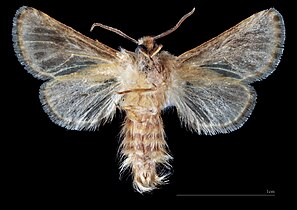Dyspessa ulula
| Dyspessa ulula | |
|---|---|

| |
| Male | |
| Scientific classification | |
| Domain: | Eukaryota |
| Kingdom: | Animalia |
| Phylum: | Arthropoda |
| Class: | Insecta |
| Order: | Lepidoptera |
| Family: | Cossidae |
| Genus: | Dyspessa |
| Species: | D. ulula
|
| Binomial name | |
| Dyspessa ulula (Borkhausen, 1790)[1]
| |
| Synonyms | |
| |
Dyspessa ulula, the garlic mottled, is a species of moth of the family Cossidae.[2] It is found from central and southern Europe through Russia to central Asia. It is also found in Syria, Iran, Iraq and parts of North Africa.
The larvae feed on Allium species, including Allium flavum, Allium vienale, Allium spaerocephalon and Allium sativum. Development of the larvae takes multiple years.
Features
[edit]Both sexes are of similar sizes. The wingspan is 18–25 mm for females and 19–26 mm for males.[3][4] On the forewings, whitish spots of varying degrees can be seen.[5] The apex is relatively pointed and the fringes are piebald. The hind wings are light ochre to yellow-gray or brownish in color. The antennae of the males are briefly double comb-toothed, those of the females are thickened and very short, comb-toothed.[6] Thorax and abdomen are covered by pale gray scales.[7] The females have a slightly longer abdomen with a protruding laying tube.
-
♂
-
♂ △
Subspecies
[edit]D. ulula has three subspecies, namely:[8]
- Dyspessa ulula ulula
- Dyspessa ulula kasrii Daniel, 1964 (Iran)
- Dyspessa ulula nigrita Wagner, 1931 (Asia Minor)
Endangerment
[edit]In Germany, the zwiebelbohrer is only found in a few regions. The species is classified in category 2 on the Red List of Threatened Species.[9]
References
[edit]- ^ Fauna Europaea
- ^ "LepIndex - ulula". www.nhm.ac.uk. Retrieved 2021-08-03.
- ^ Freina, Josef J. de; Witt, Thomas J. (1987). Die Bombyces und Sphinges der Westpalaearktis (Insecta, Lepidoptera): eine umfassende, reich illustrierte und revidierte systematische Gesamtdarstellung der Bombyces und Sphinges Europas und Nordwestafrikas in 2 Bänden (in German). Forschung & Wissenschaft. ISBN 978-3-926285-02-7.
- ^ "Dyspessa ulula GARLIC BORER". World of Butterflies and Moths. Retrieved 2021-08-03.
- ^ "Moth Photographers Group – Dyspessa ulula – 19298". mothphotographersgroup.msstate.edu. Retrieved 2021-08-03.
- ^ Rivnay, D. (2013-06-29). Field Crop Pests in the Near East. Springer Science & Business Media. ISBN 978-94-017-1544-7.
- ^ Yakovlev, Roman V.; Shapoval, Nazar A.; Ivonin, Vadim V.; Knyazev, Svyatoslav A.; Kuftina, Galina N.; Masharskiy, Alexey E. (2020-12-18). "Dyspessa ulgen Yakovlev, Shapoval, Ivonin, Knyazev & Kuftina 2020, sp. nov". doi:10.5281/zenodo.4386319.
{{cite journal}}: Cite journal requires|journal=(help) - ^ "Dyspessa ulula". insecta.pro. Retrieved 2021-08-03.
- ^ Federal Agency for Nature Conservation (Ed.): Rote Liste gefährdeter Tiere Deutschlands Landwirtschaftsverlag, Münster 1998, p. 53 (in German)
External links
[edit]


